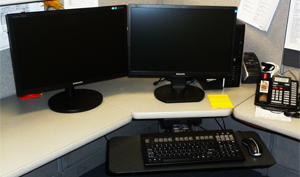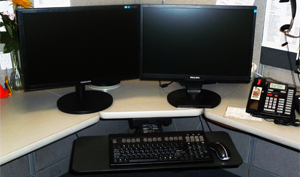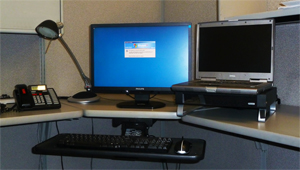Dual Monitors
Dual monitors have been in use within ESDC for the past several years. The use of two monitors at an employee’s work station does not pose any increase in ergonomic hazards if adjusted appropriately. There are actually many benefits when employees utilize dual monitors. These benefits include fewer mouse clicks, eliminating eye strain caused by having to read minimized text, working with larger fonts and better monitor resolution than using one large monitor. Also, when employees are working on spread sheets or tables, dual monitors allow the user to view all the columns rather than having to mouse between windows. As dual monitors become more common in the workplace, it is important to ensure the two monitors are adjusted to suit the user and the tasks they perform.
To assist employees in setting up dual monitors we have included the following step by step tips. We also encourage you to consult the other Self-Adjustment Ergonomic tools available on our OHS intranet site.
Tips for Setting up Dual Monitors at your Workstation:
Dual computer screens – if one is used more frequently – use the following guidelines (See photo 1)
- The primary computer screen should be in direct line of sight with sitting position
- The secondary screen should be positioned immediately to the right or left (depending on preference)
- Use shifting eye position (minimal neck rotation) when looking at the secondary screen.
- Dual monitor screens should be the same size and model and have the same fixation method to the desk top; if this is not possible, adjust to the same height and depth
- Both monitor screens should be at the same height and at the same distance, adjacent to and in line with each other with minimal angling
- Monitor screen depth should be about an arm’s length away from the seated keying position
- Arrange the monitor screen (height and angle) to allow normal gaze to fix within the top third to the middle of the screen
- Adjust both monitor screen settings so that text size, font, colour brightness and contrast are the same
Photo – 1
Dual computer screens – if both are used equally – use the following guidelines (See photo 2)
- Centre the two monitors in line with the seated keying position.
- Repeat steps 4, 5, 5a), 5b) and 6.
Photo – 2
Dual computer screens – if one is used more frequently and one is a notebook – use the following guidelines (See photo 3)
- When one of the screens is a notebook and it is used less frequently than the main computer monitor, position the notebook on a monitor riser or sturdy base
- Repeat step 2, 3, 4, 5, 5a), 5b) and 6.
Photo – 3